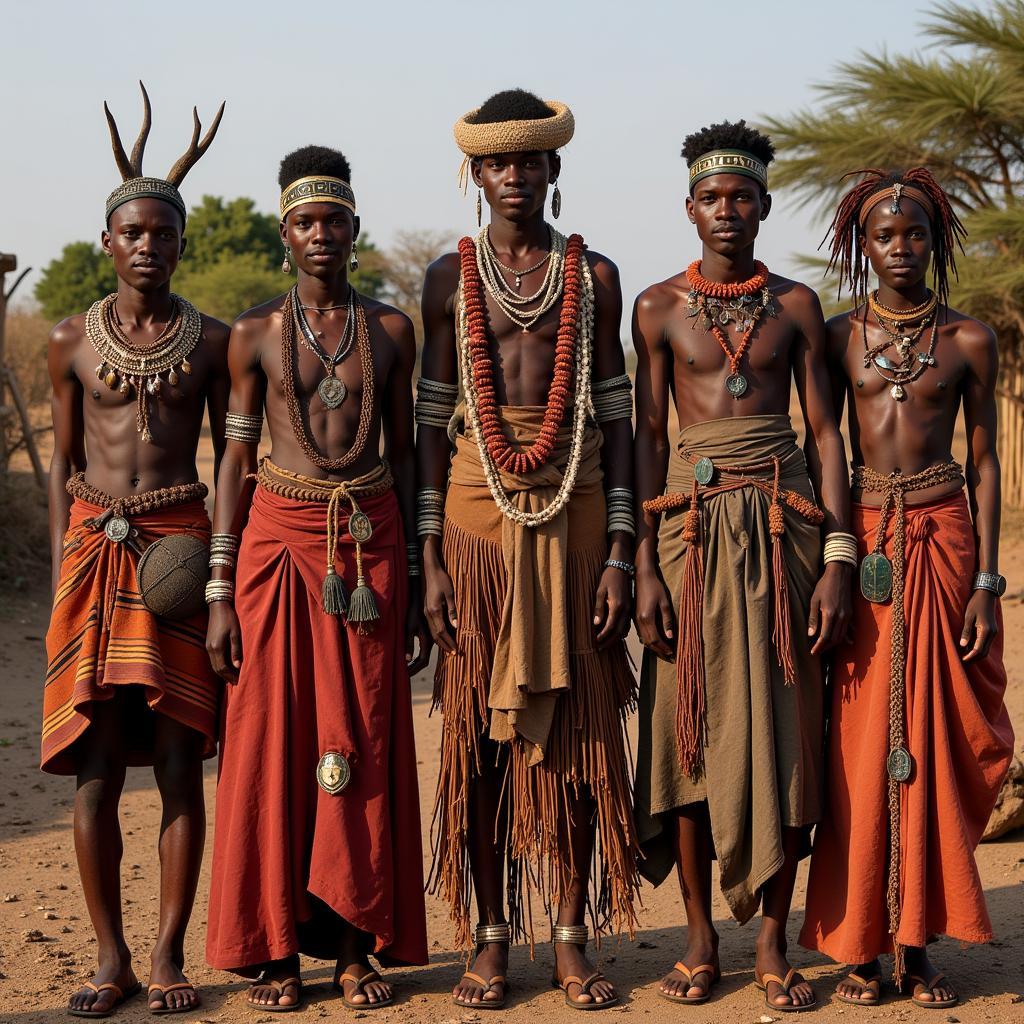African Grassland Animals List: A Guide to the Savanna’s Majestic Fauna
The African grasslands, also known as savannas, are teeming with a diverse array of wildlife. From iconic predators like lions and cheetahs to gentle giants like elephants and giraffes, this vast ecosystem is home to a captivating cast of characters. This comprehensive African Grassland Animals List will explore the fascinating world of these incredible creatures and their unique adaptations.
The Big Five and Beyond: Iconic African Grassland Animals
The term “Big Five” originated from the five most difficult animals to hunt on foot in Africa and has since become synonymous with safaris and wildlife watching. These majestic creatures include:
- African Lion (Panthera leo): The apex predator of the savanna, lions are known for their powerful roars and social structure. They typically live in prides, with females leading the hunts.
- African Leopard (Panthera pardus): Masters of camouflage and stealth, leopards are solitary hunters with a powerful build and a distinctive spotted coat.
- African Bush Elephant (Loxodonta africana): The largest land mammal on Earth, elephants play a vital role in shaping the savanna ecosystem. Their immense size and strength make them true giants of the grasslands.
- Cape Buffalo (Syncerus caffer): Known for their unpredictable nature and formidable horns, Cape buffalo are powerful grazers that form large herds.
- Black Rhinoceros (Diceros bicornis): Critically endangered, black rhinos are solitary animals with a distinctive prehensile upper lip for feeding on vegetation.
While the Big Five are undoubtedly impressive, the African grasslands are teeming with many other fascinating creatures.
Herbivores: The Gentle Giants and Grazers
The vast plains of the African savanna are home to a diverse array of herbivores, from the towering giraffe to the graceful zebra. These animals have evolved unique adaptations to thrive on the abundant grasses and foliage:
- Giraffe (Giraffa camelopardalis): With its long neck, legs, and distinctive spotted pattern, the giraffe is the tallest mammal on Earth. It can reach vegetation high in the trees.
- Zebra (Equus quagga, E. zebra, E. grevyi): Known for their striking black and white stripes, zebras are social animals that form large herds. Their stripes are thought to confuse predators and regulate body temperature. You can find more information about zebras and their Asian elephant counterparts on our page about African and Asian elephant pictures.
- Wildebeest (Connochaetes taurinus): Also known as gnus, wildebeest are large antelope known for their annual migrations in search of fresh grazing lands.
- African Plains Zebra (Equus quagga): The most common and geographically widespread zebra species, African Plains zebras exhibit distinct stripe patterns that vary between populations.
Predators: The Thrill of the Chase
The African grasslands are a battleground for survival, where predators and prey engage in a constant struggle for dominance. Some of the most iconic predators include:
- African Wild Dog (Lycaon pictus): Known for their incredible stamina and cooperative hunting strategies, African wild dogs are highly endangered.
- Cheetah (Acinonyx jubatus): The fastest land animal, the cheetah can reach incredible speeds in short bursts when pursuing prey. You can learn more about this incredible creature on our African cheetah facts page.
The Smaller Wonders: Birds, Reptiles, and Insects
Beyond the larger mammals, the African grasslands are teeming with a rich diversity of smaller creatures, each playing a vital role in the ecosystem:
- Birds: From the majestic African fish eagle (Haliaeetus vocifer) to the colorful lilac-breasted roller (Coracias caudatus), the grasslands are home to a vibrant array of birdlife.
- Reptiles: Nile crocodiles (Crocodylus niloticus) lurk in waterways, while rock pythons (Python sebae) are ambush predators that constrict their prey.
- Insects: From dung beetles to termites, insects play a crucial role in nutrient cycling and decomposition.
Threats and Conservation Efforts
The incredible biodiversity of the African grasslands faces numerous threats, including habitat loss, poaching, and climate change. Conservation efforts are crucial to protect these animals and their environment.
“Protecting the African grasslands is not just about preserving wildlife but about safeguarding a vital part of our planet’s natural heritage,” says Dr. Amani Nkosi, a leading conservation biologist specializing in African ecosystems. “These grasslands provide essential ecosystem services and are home to a cultural legacy that must be passed on to future generations.”
Exploring the African Grasslands
For many, experiencing the African grasslands is a once-in-a-lifetime adventure. Whether you’re visiting the African grasslands at Omaha Zoo or embarking on a safari in Africa, witnessing these animals in their natural habitat is an unforgettable experience.
This African grassland animals list provides just a glimpse into the incredible diversity of this unique ecosystem. From the smallest insects to the largest mammals, each creature plays a vital role in maintaining the delicate balance of the savanna.
FAQs About African Grassland Animals
1. What is the largest animal found in the African grasslands?
The African bush elephant (Loxodonta africana) is the largest land animal on Earth and a resident of the African grasslands.
2. What is the fastest land animal?
The cheetah (Acinonyx jubatus), residing in the African grasslands, is the fastest land animal, capable of reaching speeds up to 70 miles per hour in short bursts.
3. Why are African wild dogs endangered?
African wild dogs face threats from habitat loss, disease, and human conflict, leading to their endangered status. You can find more information about the conservation status of the African cheetah on our page about the IUCN status of the African cheetah.
4. What is the significance of the “Big Five”?
The “Big Five” – lion, leopard, elephant, buffalo, and rhinoceros – were historically the most challenging animals to hunt on foot, now representing iconic safari animals.
5. What are some of the conservation challenges facing African grasslands?
Habitat loss due to human development, poaching for illegal wildlife trade, and climate change are among the major threats impacting African grasslands.
Explore More About African Wildlife
- Learn about the diverse habitats of Africa
- Discover the cultural significance of African wildlife
- Get involved in conservation efforts to protect these animals
For any assistance, feel free to contact us.
Phone Number: +255768904061
Email: kaka.mag@gmail.com
Address: Mbarali DC Mawindi, Kangaga, Tanzania
We have a 24/7 customer service team.


